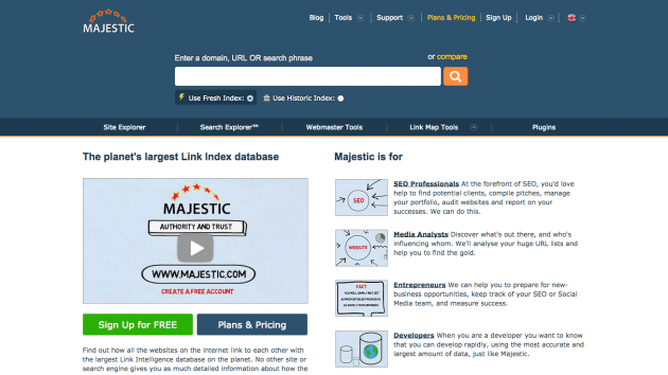Sure, link building may important but that doesn’t mean it’s only for professionals. With a little time investment, you can start link building yourself. In our first post we looked at the “what” of link building; in this post we’re concentrating on the “how”.
No shortcuts: the best content gets links
What should be your number one priority when it comes to link building? Creating and maintaining a great website. Then other websites will naturally want to link to you. No begging, no coercion, no payment—just excellent content that others will spontaneously link to because it’s so damn good. This is the whitest of white hat (i.e., search engine-approved) link building, which means that it’s immune to Google’s future algorithm updates and should keep your rankings strong over the long haul.
Nice design certainly helps, but you can’t build links with something that’s all style, no substance. What your website needs is great content: y’know, interesting information, useful insights, compelling research, relevant news—stuff like that. One of the best ways to do this is to maintain a blog. It used to be that blogs were little more than glorified personal diaries, but these days they’re a respectable and popular medium for businesses. In fact, research shows that business blogging leads to 97% more backlinks and 55% more website visitors.
Imagine you run a bookstore; one of those real book lovers’ joints where the staff all hold English lit degrees. You can maintain an interesting and insightful blog with book reviews, top-10 lists and store news. You know your stuff and your customers are hooked. One week, you profile on a local author on your blog, an emerging writer who hasn’t had a lot of press elsewhere. That author, grateful for the exposure, will probably link to the post on her own blog. Reviewers, looking for information the author, might also link to your post. And with a little luck, a news site may well link to you when they profile the author about a year later once she’s hit the big time and won a literary award—that’s a real coup, since news sites have real rank-boosting authority. And all you’ve done is write the piece.
Content that’ll leave your readers content
Some content tends to draw backlinks. Tried-and-true formats include:
- Definitive guides. Encyclopedic guidebooks to a particular topic. Be comprehensive and hire a designer to make it look stellar. Example: The Advanced Guide to Link Building.
- Infographics. Complex information presented in a visually-interesting way. Most of the best infographics take statistics on a particular topic and break it down into groovy charts and graphs. Again, a designer could be make-or-break, though resources like Infrogr.am and Visual.ly enable you to create DIY infographics. Example: 10 Most Popular Dog Breeds Nationwide.
- Numbered lists. Lists of the best or biggest or baddest in a particular category. It seems that our brains are hardwired to love numbered lists. Use the numerals, rather than the word, in the title (e.g., “10 Reasons…”, not “Ten Reasons…”), since visual difference is part of their appeal. Example: Top 10 Breaking Bad Moments of 2013.
- “Whoa”-inducing pieces. Any content that’s mind-boggling. Often this can be done by combining definitive guides with numbered lists e.g., “333 Ways to Skin a Cat” (please don’t). The sheer number here has the “wow” factor. Example: 500 Reasons to Love Football.
- Expert round ups. Contacting a number of gurus in a particular field and getting their opinion or ideas on a topic, then collating it. It’s a concentration of great minds in one place, which is bound to be compelling. Example: 24 SEO Experts Discuss Links vs. Tweets.
- Quizzes. A quiz centered on a relevant topic. You’re either appealing to people’s competitive instinct (“I’m gonna get 100% on this bad boy”) or their narcissism (“Hmmm, I wonder what sex symbol I’m most like…”). There are tools to create quizzes, like WP-Pro-Quiz (for Wordpress sites). Examples: How Millennial Are You?
But the sky, as they say, is the limit. The point is to create something brilliant. Be creative but also informative but also interesting but also well-researched but also succinct but also thorough. Do this and do it regularly, and the backlinks will come quite naturally…
Spreading the word: why the content king can’t go it alone
...Or not. “Content is king” has virtually become a truism in the marketing world, functioning as a corrective to SEO hucksters with little regard for website quality—but is it true? Ross Hudgens of Siege Media doesn’t think so. Well, not without qualification, at least. He makes the point that it’s possible to create outstanding content, yet still garner very little attention—and therefore very few backlinks. So while it’s well nigh impossible to engage in white hat link building successfully without it, rip-roaring good content alone is not enough.
The next step is letting people know that your content is there and it’s worth linking to. Those in the biz often refer to this as outreach. True link building goes beyond crafting grade-A content and actually plugging that content to other sites. Perhaps the most straightforward way to do this—drum roll, please—is to email a webmaster and ask if they’ll post a link to your site. Sure, you might get a “no” or, more likely, stony silence, but even if just a fraction respond positively, then you’ve just landed yourself some handy backlinks.
Don’t take a shotgun approach to this though. Be selective with who you contact; you want your links to come from sites relevant to your field, and you want them to have sufficient oomph to be able to be able to help give your rankings a boost. You can find out the “power” that a particular website has (and can therefore pass some of that onto you via a backlink) with various tools. For instance, to find out Google’s PageRank—how much authority Google sees a site as having—install SEOBook’s SEO toolbar, which will reveal the PageRank for every page you visit. To find out how trusted a particular site is, type in the web address into MajesticSEO and view its’ “trust flow”. The higher these ratings, the more profitable they’ll be if backlinking to your site.
One easy way to pick some sites to target is simply search for a few keywords and phrases relevant to your topic in Google. Then get in touch with the webmasters of the sites that ranked highly for those search queries. If you personalise the email, show a genuine interest in their website and, of course, are creating truly link-worthy content, then you increase your chances.
A more sophisticated approach is to find out what backlinks other similar, high-ranking sites have earned then try and acquire backlinks from those same sites. You can find other site’s backlinks this using Open Site Explorer, “The Search Engine for Links”. Just type in the web address of a similar site and you’ll get a list of all their backlinks. And for the truly ruthless, Darwinian link-builder, there’s always link poaching: contacting a webmaster and requesting that they replace a link to your competitor’s site with a link to yours instead. Though I’d suggest that the only way to this without being the World’s Biggest Jerk is to create content that is so infinitely superior to the previous link’s that it deserves to be there in its place. Keep telling yourself that anyway.
You might also consider submitting your site to various directories. For instance, if you’re a New Zealand-based business, Finda could be well worth your time. And something like Google “My Business” is also a must, not only for the links but for a bunch of other reasons. Directory backlinks are supposedly not be as potent as they used to be, but they’re still definitely worth a shot.
But what about websites that have a lot more authority? Is it possible to score a backlink from them? It is if you get creative. SEO experts Neil Patel and Brian Dean talk about how to land links from .edu (NZ: .ac.nz, UK: .ac.uk) websites. If you’re running a hospitality or tourism business, get in touch with the admissions/enrolment office at local tertiary institutions. These sites sometimes link to nearby hotels, restaurants, and tourist attractions as a service to visiting prospective students. This kind of lateral thinking can land you backlinks from high-authority websites that pack real SEO power.
One advanced technique that is making a comeback now that white hat SEO is de rigueur broken link building. This involves finding old blog posts and pages with links that are “broken”, no longer linking to the page they should—this happens pretty frequently, as a lot of pages are eventually moved or taken down altogether. Once you’ve found a page with some broken links, you have to knuckle-down and scour the net to find quality replacements, pages that serve as adequate substitutes for the links that no longer go anywhere. Stick to sites that are in the same niche as your own site and you’ll be able to work in a select few of your own blog posts, essentially creating your own backlinks. Having said that, it makes sense to include links to others’ sites too. Once you’ve come up with replacements, contact the webmaster. Kindly explain that you discovered some broken links in their old posts and, in order to save them time, you’ve come up with suitable fresh, new links. Most bloggers are keen to keep their content up-to-date so you’re doing them a favour. But, of course, you’re also getting one or two handy backlinks yourself. Win-win!
But wait—there’s more! In Part 3 of this blog series we nut out how to extend your link building reach by taking control of your own backlinking.





